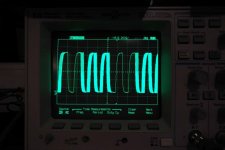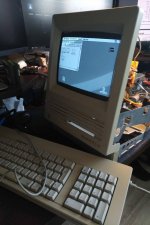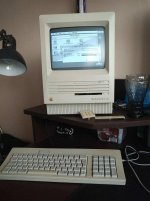Hi,
Just bought Macintosh Plus and Macintosh SE 1/40 on local market. Plus works (but I need a keyboard ), SE was known to be broken / showing only horizontal dotted line (not solid).
), SE was known to be broken / showing only horizontal dotted line (not solid).
After disassembly I saw this mess:
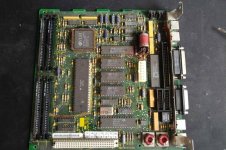
After touching battery it got even worse it was still half-full of it's content. I washed the board using IPA and toothbrush, then under shower, under IPA again and got it almost clean.
Weird is that no traces got corroded, only some pass-throughs near battery that I was able to fix quickly.
Now it boots to this checkerboard-like pattern. Pattern itself depends on how many/what configuration of RAM sticks is installed. Board was configured to 2/4MB, sticks are unknown size - two "GB11000S-8/9" with 8x KM41C10000BJ-8 chips (google gives no results) and two Nec MC-157A with 2x Nec 424256-80 (so probably 512k/stick)
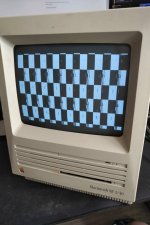
Up to now I checked voltages on external floppy connector - both 5v and 12v are fine. Checked analog board for visible bad joints - all looks OK. Of course in case of this leak disaster, traditional troubleshooting won't help so I'm looking for any clues.
Unfortunately googling for checkerboard pattern gives only "bad capacitors" results, no technical explanation what this state shows or where to look. I have a 100MHz scope to poke around, just need any info where to start.
Just bought Macintosh Plus and Macintosh SE 1/40 on local market. Plus works (but I need a keyboard
After disassembly I saw this mess:

After touching battery it got even worse it was still half-full of it's content. I washed the board using IPA and toothbrush, then under shower, under IPA again and got it almost clean.
Weird is that no traces got corroded, only some pass-throughs near battery that I was able to fix quickly.
Now it boots to this checkerboard-like pattern. Pattern itself depends on how many/what configuration of RAM sticks is installed. Board was configured to 2/4MB, sticks are unknown size - two "GB11000S-8/9" with 8x KM41C10000BJ-8 chips (google gives no results) and two Nec MC-157A with 2x Nec 424256-80 (so probably 512k/stick)

Up to now I checked voltages on external floppy connector - both 5v and 12v are fine. Checked analog board for visible bad joints - all looks OK. Of course in case of this leak disaster, traditional troubleshooting won't help so I'm looking for any clues.
Unfortunately googling for checkerboard pattern gives only "bad capacitors" results, no technical explanation what this state shows or where to look. I have a 100MHz scope to poke around, just need any info where to start.

